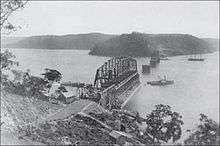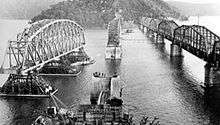Hawkesbury River Railway Bridge
| Hawkesbury River Railway Bridge | |
|---|---|
 Bridge looking north | |
| Coordinates | 33°32′2″S 151°13′42.3″E / 33.53389°S 151.228417°ECoordinates: 33°32′2″S 151°13′42.3″E / 33.53389°S 151.228417°E |
| Carries | Main Northern railway line |
| Crosses | Hawkesbury River |
| History | |
| Opened |
1 May 1889 (1st) 1 July 1946 (2nd) |
The Hawkesbury River Railway Bridge carries the Main Northern railway line across the Hawkesbury River just north of the town of Brooklyn on the northern outskirts of Sydney, Australia. The railway bridge was to be the last link in a railway network that linked Adelaide, Melbourne, Sydney and Brisbane and was a major engineering feat at the time.
Before the bridge
On 7 April 1887, the single track section of the Main Northern line was opened between Hornsby and the Hawkesbury River. Passengers and goods heading north now unloaded at the River Wharf platform on the eastern end of Long Island, transferring to the double decker, rear paddled-wheeled steamer General Gordon for a three-hour trip out to Broken Bay and up Brisbane Water to Gosford where the train service recommenced. Once the 1.7 km long Woy Woy Tunnel was opened on 15 August 1887, the trip was considerably shortened as the boat only had to cross the river and negotiate the lower reaches of Mullet Creek to reach Mullet Creek station.[1][2]
First bridge


.jpg)

The Union Bridge Company of New York was awarded the contract to construct the bridge in January 1886. However, subcontractors were also involved in the actual construction work. The piers consisted of concrete below water with sandstone masonry above. The spans were assembled on Dangar Island and floated 1,500 metres (4,921 ft) or so across to the bridge site on barges.
The bridge had seven spans of 416 feet (127 m) each for a total length of 2,910 feet (890 m). Five of the piers were sunk to then record depths of between 150 to 160 feet (46 to 49 m) below high water. The bridge officially opened on 1 May 1889.[1]
Load testing
At the time, it was the longest structure to be load tested in Australia and so two distinct and separate methods were used. Firstly, optical measurements were taken of the deformation under load at the centre of each span, taken by two sets of observers positioned atop the stone piers. The second test used a water gauge to accurately measure the deformation and the amount of deflection or "set" for each span.
Load testing was carried out on 24 April 1889 in the presence of various dignitaries including Henry Deane, the Assistant Engineer in Chief of the New South Wales Government Railways. During the morning, each span was tested separately by slowly running trains out onto the span, taking the required measurements, backing the train off again and retaking the measurements. This was repeated for each span but on the second span it was found that the optical readings did not match with the water gauge. The cause was found to be a slow leak in a connecting pipe of the water gauge equipment. There was only one water gauge available and as the leak would become worse as the equipment was moved from span to span for each reading it was decided to abandon this method and rely wholly on the optical readings.
A speed test was undertaken during the afternoon by four locomotives, coupled in two pairs. They were started off by a flagman standing above the Long Island tunnel and the trains ran across the causeway from Hawkesbury River station through the Long Island tunnel and out across the bridge at maximum speed.
Problems arise
Although the track on either end of the bridge was single line, the bridge itself was constructed to double track width with an eye to the future duplication of the line. This led to the undesirable practice of the bridge being used as a crossing point for trains, thus regularly subjecting the structure to maximum stress loads.
The bridge gave admirable service until 1927 when it required strengthening. In 1938 a severe crack in one of the piers was discovered and it became necessary to replace the entire structure. The depth of sediment had made it impossible to reach bedrock with the foundations on the southernmost pier and it seems that this was the cause of the structural faults. The amount of traffic being carried (up to 100 trains a day) during World War II made the replacement extremely urgent and prior to the new bridge being brought into operation the speed limit on the old bridge was restricted to 14 miles per hour (23 km/h) and finally down to 4 miles per hour (6 km/h) with tracks altered to gauntlet configuration to ensure trains could not pass.[2][3][4]
Second bridge
Work commenced on the new bridge in July 1940 and despite best efforts it was not completed until after the war finished, opening for traffic on 1 July 1946. The new bridge was positioned 60 metres (197 ft) to the west or upstream of the original bridge and consists of eight spans in three different lengths and piers sunk to depths of up to 183 feet (56 m).[5] New tunnels were bored through Long Island to the south and Cogra Point on the northern approach.[1]
The spans for the new bridge were constructed adjacent to the bridge site on the northern side of Long Island, raised to the correct height, placed onto barges and floated out to the piers at high tide. Upon completion of the new bridge, the old bridge was removed, however the sandstone capped piers remain. The construction docks remain in situ.[1]
Issues
In 2016, a report revealed cracking in concrete pilons as well as "consistent defects" in the steel frame of the bridge. As a result, limits are planned to be imposed on the weight capacity of freight trains crossing the bridge, pending possible strengthening of sections of the bridge to allow heavier loads.[6]
References
- 1 2 3 4 Hawkesbury River Rail Bridge & Long Island Group NSW Environment & Heritage
- 1 2 "Byways of Steam Hawkesbury River & Hornsby" Roundhouse October 1984 pages 4-30
- ↑ "HAWKESBURY BRIDGE DEFECT SPREADS". The Sun (8961). New South Wales, Australia. 24 September 1938. p. 3 (LATE FINAL EXTRA). Retrieved 31 August 2016 – via National Library of Australia.
- ↑ "HAWKESBURY BRIDGE.". The Sydney Morning Herald (31,430). New South Wales, Australia. 26 September 1938. p. 13. Retrieved 31 August 2016 – via National Library of Australia.
- ↑ "ENGINEERING ASSOCIATION.". The Sydney Morning Herald (15,173). New South Wales, Australia. 12 November 1886. p. 4. Retrieved 31 August 2016 – via National Library of Australia.
- ↑ Saulwick, Jacob (2 December 2016). "Freight limits imposed after defects found in Hawkesbury River rail bridge". The Sydney Morning Herald. Fairfax Media. Retrieved 2 December 2016.
- Australian Encyclopaedia Vol II and VII. Angus and Robertson. 1950.
- Australian Railway Historical Society Bulletin no. 541 Volume XXXIII November 1982
- Australian Railway Historical Society Bulletin no. 334 Volume XVI August 1965
- Nock, O. S. (Oswald Stevens) (1971), Railways of Australia, Adam & Charles Black, ISBN 978-0-7136-1190-8
External links
![]() Media related to Hawkesbury River Railway Bridge at Wikimedia Commons
Media related to Hawkesbury River Railway Bridge at Wikimedia Commons